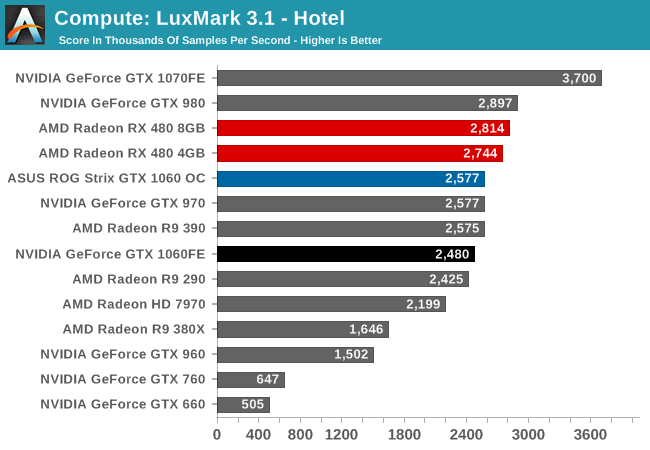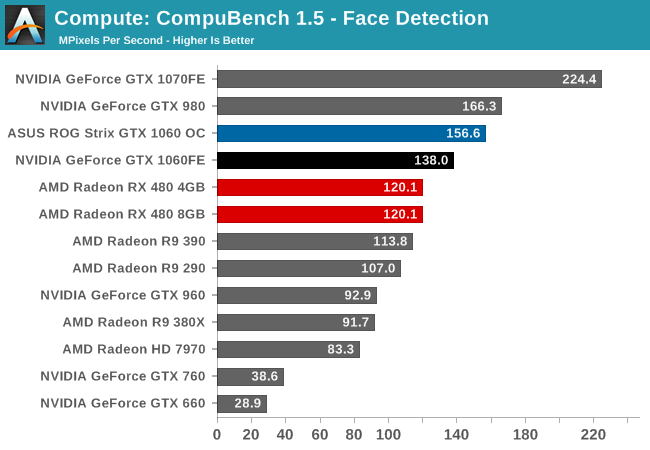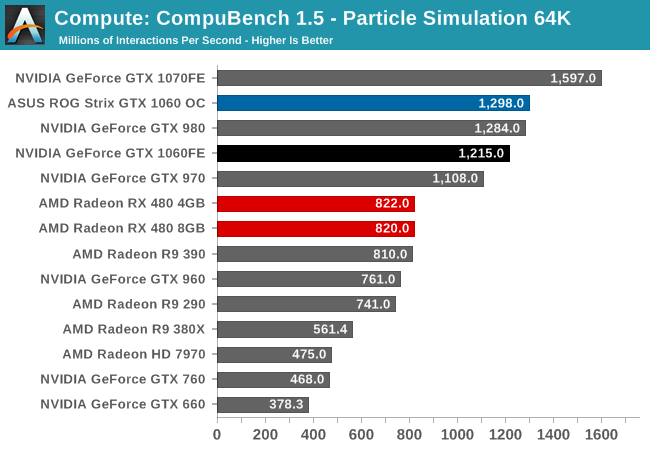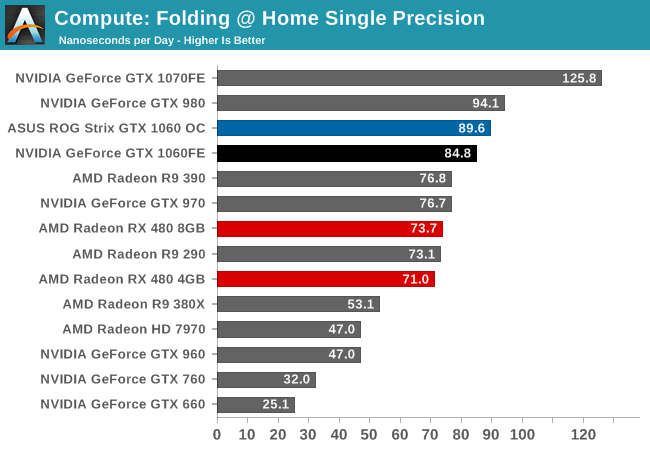The GeForce GTX 1060 Founders Edition & ASUS Strix GTX 1060 Review
by Ryan Smith on August 5, 2016 2:00 PM ESTCompute
Shifting gears, let’s take a look at compute performance on GTX 1060.
As we already had the chance to categorize the Pascal architecture’s compute performance in our GTX 1080 review, there shouldn’t be any surprises here. But it will be interesting to see whether the GTX 1060’s higher ratio of memory bandwidth per FLOP materially impacts overall compute performance.
Starting us off for our look at compute is LuxMark3.1, the latest version of the official benchmark of LuxRender. LuxRender’s GPU-accelerated rendering mode is an OpenCL based ray tracer that forms a part of the larger LuxRender suite. Ray tracing has become a stronghold for GPUs in recent years as ray tracing maps well to GPU pipelines, allowing artists to render scenes much more quickly than with CPUs alone.

While GTX 1060 could hang with GTX 980 in gaming benchmarks, we don’t start off the same way with compute benchmarks, with the last-generation flagship holding about 17% ahead. Unfortunately for NVIDIA, this is about where GTX 1060 needed to be to best RX 480; instead it ends up trailing the AMD competition. Otherwise the performance gain versus the GTX 960 stands at 65%.
For our second set of compute benchmarks we have CompuBench 1.5, the successor to CLBenchmark. CompuBench offers a wide array of different practical compute workloads, and we’ve decided to focus on face detection, optical flow modeling, and particle simulations.



Like with GTX 1080, relative performance is all over the place. GTX 1060 wins with face detection, loses at optical flow, and wins again at particle simulation. Even the gains versus GTX 960 are a bit more uneven, though at the end of the day GTX 1060 ends up being significantly faster than its predecessor with all 3 sub-benchmarks.
Moving on, our 3rd compute benchmark is the next generation release of FAHBench, the official Folding @ Home benchmark. Folding @ Home is the popular Stanford-backed research and distributed computing initiative that has work distributed to millions of volunteer computers over the internet, each of which is responsible for a tiny slice of a protein folding simulation. FAHBench can test both single precision and double precision floating point performance, with single precision being the most useful metric for most consumer cards due to their low double precision performance. Each precision has two modes, explicit and implicit, the difference being whether water atoms are included in the simulation, which adds quite a bit of work and overhead. This is another OpenCL test, utilizing the OpenCL path for FAHCore 21.


Finally, in Folding@Home, we see the usual split between single precision and double precision performance. GTX 1060 is solidly in the lead when using FP32, but NVIDIA’s poor FP64 rate means that if double precision is needed, RX 480 will pull ahead.










189 Comments
View All Comments
Wall Street - Friday, August 5, 2016 - link
Yeah, it is amazing how many times the text "$249" appears in this review of a $299 card and a $314 card. Ryan is fully feeding into nVidia's price anchoring. I think that if the price chart shows $249 for the GTX 1060, then it should also show $299, because the $249 cards are nowhere to be found and explicitly not the ones he looked at.Ryan Smith - Friday, August 5, 2016 - link
The entire Founders Edition things makes reviewing a bit more complicated. But since it's purely a stock card from a performance perspective, it's a very reasonable proxy for the $249 cards. No GTX 1070 is going to under perform the 1060FE, because that's the minimum specs allowed to begin with.Wall Street - Saturday, August 6, 2016 - link
With Turbo Boost, I am not 100% sure that the single fan Zotac or EVGA 1060s which are the actual $249 cards will maintain the same clocks as the founders edition will.Samus - Sunday, August 7, 2016 - link
What's depressing (for me anyway) is this card consistently outperforms my 970 in the games I play...and my 970 cost substantially more just a year ago. It's pretty unusual for a mainstream card to overtake an enthusiast card in one generation.Death666Angel - Sunday, August 7, 2016 - link
Well, this was a full node shrink (no half node) and a much more advanced process (FinFET), so unfortunately, it was very likely. However, you've had a good year of great performance out of your 970, so not too much to complain about there. :DSamus - Monday, August 8, 2016 - link
True. The 970 will hold tight until I eventually graduate from 1920x1200 to 2560x1600.spbx - Friday, August 5, 2016 - link
after anand left thing weren't the same :(BrokenCrayons - Friday, August 5, 2016 - link
So true! There was a huge decline in the use of capital letters and punctuation by readers in the comments section.Cygni - Friday, August 5, 2016 - link
Yeah, the influx of the same terrible negativity posters from other websites has really been annoying lately.Morawka - Friday, August 5, 2016 - link
That's what popularity and the reddit crowd will bring.